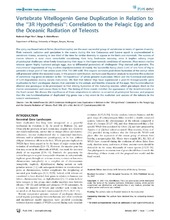Vertebrate Vitellogenin Gene Duplication in Relation to the ‘‘3R Hypothesis’’: Correlation to the Pelagic Egg and the Oceanic Radiation of Teleosts
Peer reviewed, Journal article
Permanent lenke
https://hdl.handle.net/1956/2588Utgivelsesdato
2007Metadata
Vis full innførselSamlinger
Originalversjon
https://doi.org/10.1371/journal.pone.0000169Sammendrag
The spiny ray-finned teleost fishes (Acanthomorpha) are the most successful group of vertebrates in terms of species diversity. Their meteoric radiation and speciation in the oceans during the late Cretaceous and Eocene epoch is unprecedented in vertebrate history, occurring in one third of the time for similar diversity to appear in the birds and mammals. The success of marine teleosts is even more remarkable considering their long freshwater ancestry, since it implies solving major physiological challenges when freely broadcasting their eggs in the hyper-osmotic conditions of seawater. Most extant marine teleosts spawn highly hydrated pelagic eggs, due to differential proteolysis of vitellogenin (Vtg)-derived yolk proteins. The maturational degradation of Vtg involves depolymerization of mainly the lipovitellin heavy chain (LvH) of one form of Vtg to generate a large pool of free amino acids (FAA 150–200 mM). This organic osmolyte pool drives hydration of the ooctye while still protected within the maternal ovary. In the present contribution, we have used Bayesian analysis to examine the evolution of vertebrate Vtg genes in relation to the ‘‘3R hypothesis’’ of whole genome duplication (WGD) and the functional end points of LvH degradation during oocyte maturation. We find that teleost Vtgs have experienced a post-R3 lineage-specific gene duplication to form paralogous clusters that correlate to the pelagic and benthic character of the eggs. Neo-functionalization allowed one paralogue to be proteolyzed to FAA driving hydration of the maturing oocytes, which pre-adapts them to the marine environment and causes them to float. The timing of these events matches the appearance of the Acanthomorpha in the fossil record. We discuss the significance of these adaptations in relation to ancestral physiological features, and propose that the neo-functionalization of duplicated Vtg genes was a key event in the evolution and success of the teleosts in the oceanic environment.
